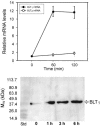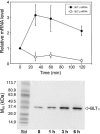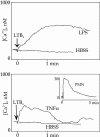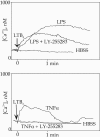Differential induction of BLT receptor expression on human endothelial cells by lipopolysaccharide, cytokines, and leukotriene B4
- PMID: 16624877
- PMCID: PMC1440767
- DOI: 10.1073/pnas.0602208103
Differential induction of BLT receptor expression on human endothelial cells by lipopolysaccharide, cytokines, and leukotriene B4
Abstract
Leukotriene (LT) B4 is a powerful chemotactic and immune modulating agent that signals via two receptors denoted BLT1 and BLT2. Here we report that BLT1 and BLT2 are expressed at low levels in an apparently silent state in human umbilical vein endothelial cells (HUVEC). However, treatment with LPS leads to a >10 fold increase in the levels of BLT1 mRNA without any significant effects on BLT2 mRNA. In parallel, LPS also increases the amounts of BLT1 protein. Tumor necrosis factor-alpha (TNF-alpha) increases the expression of BLT2 mRNA approximately 6 times above basal levels with only a modest increase in BLT1 mRNA. Interleukin-1beta causes variable and parallel increases of both BLT1 and BLT2 mRNA. The natural ligand LTB4 also increases BLT1, but not BLT2, mRNA and protein expression. Along with the induction of BLT1 and/or BLT2, HUVEC acquire the capacity to respond to LTB4 with increased levels of intracellular calcium and these signals can be blocked by isotype selective BLT antagonists, CP-105696 and LY-255283. In addition, treatment of HUVEC with LTB4 causes increased release of both nitrite, presumably reflecting nitric oxide (NO), and monocyte chemoattractant protein-1. Our data indicate that expression of functional BLT receptors may occur at the surface of endothelial cells in response to LPS, cytokines, and ligand, which in turn may have functional consequences during the early vascular responses to inflammation. Moreover, the results point to BLT receptors as potential targets for pharmacological intervention in LT-dependent inflammatory diseases such as asthma, rheumatoid arthritis, and arteriosclerosis.
Conflict of interest statement
Conflict of interest statement: No conflicts declared.
Figures







Similar articles
-
Leukotriene B4 receptors BLT1 and BLT2: expression and function in human and murine mast cells.J Immunol. 2006 Sep 1;177(5):3439-47. doi: 10.4049/jimmunol.177.5.3439. J Immunol. 2006. PMID: 16920986
-
Leukotriene B4 receptors.Prostaglandins Other Lipid Mediat. 2002 Aug;68-69:575-85. doi: 10.1016/s0090-6980(02)00056-4. Prostaglandins Other Lipid Mediat. 2002. PMID: 12432944 Review.
-
Leukotriene B4 enhances the activity of nuclear factor-kappaB pathway through BLT1 and BLT2 receptors in atherosclerosis.Cardiovasc Res. 2009 Jan 1;81(1):216-25. doi: 10.1093/cvr/cvn277. Epub 2008 Oct 13. Cardiovasc Res. 2009. PMID: 18852255
-
Recent advances in function and structure of two leukotriene B4 receptors: BLT1 and BLT2.Biochem Pharmacol. 2022 Sep;203:115178. doi: 10.1016/j.bcp.2022.115178. Epub 2022 Jul 16. Biochem Pharmacol. 2022. PMID: 35850310 Review.
-
A turn on and a turn off: BLT1 and BLT2 mechanisms in the lung.Expert Rev Respir Med. 2014 Aug;8(4):381-3. doi: 10.1586/17476348.2014.908715. Epub 2014 Apr 18. Expert Rev Respir Med. 2014. PMID: 24742066
Cited by
-
Evaluation of the Inhibitory Effects of Pyridylpyrazole Derivatives on LPS-Induced PGE2 Productions and Nitric Oxide in Murine RAW 264.7 Macrophages.Molecules. 2021 Oct 27;26(21):6489. doi: 10.3390/molecules26216489. Molecules. 2021. PMID: 34770896 Free PMC article.
-
Expression of functional leukotriene B4 receptors on human airway smooth muscle cells.J Allergy Clin Immunol. 2009 Jul;124(1):59-65.e1-3. doi: 10.1016/j.jaci.2009.03.024. Epub 2009 May 27. J Allergy Clin Immunol. 2009. PMID: 19477492 Free PMC article.
-
Leukocytes regulate retinal capillary degeneration in the diabetic mouse via generation of leukotrienes.J Leukoc Biol. 2013 Jan;93(1):135-43. doi: 10.1189/jlb.0112025. Epub 2012 Oct 29. J Leukoc Biol. 2013. PMID: 23108096 Free PMC article.
-
Leukotrienes as modifiers of preclinical atherosclerosis?ScientificWorldJournal. 2012;2012:490968. doi: 10.1100/2012/490968. Epub 2012 May 1. ScientificWorldJournal. 2012. PMID: 22645425 Free PMC article. Review.
-
Synthesis of New Triarylpyrazole Derivatives Possessing Terminal Sulfonamide Moiety and Their Inhibitory Effects on PGE₂ and Nitric Oxide Productions in Lipopolysaccharide-Induced RAW 264.7 Macrophages.Molecules. 2018 Oct 7;23(10):2556. doi: 10.3390/molecules23102556. Molecules. 2018. PMID: 30301280 Free PMC article.
References
-
- Samuelsson B. Science. 1983;220:568–575. - PubMed
-
- Funk C. D. Science. 2001;294:1871–1875. - PubMed
-
- Ford-Hutchinson A. W., Bray M. A., Doig M. V., Shipley M. E., Smith M. J. H. Nature. 1980;286:264–265. - PubMed
-
- Malmsten C., Palmblad J., Udén A.-M., Rådmark O., Engstedt L., Samuelsson B. Acta Physiol. Scand. 1980;110:449–451. - PubMed
-
- Goodarzi K., Goodarzi M., Tager A. M., Luster A. D., von Andrian U. H. Nat. Immunol. 2003;4:965–973. - PubMed
Publication types
MeSH terms
Substances
LinkOut - more resources
Full Text Sources
Other Literature Sources
Research Materials
Miscellaneous

